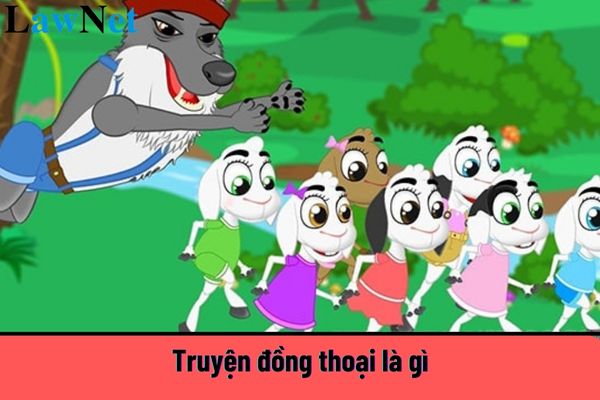Vietnam: What is a children's story? What are the characteristics of a children's story? What are the basic features of Literature for secondary students?
What is a children's story? What are the characteristics of a children's story?
A children's story is a special literary genre for children where the main characters are often animals, plants, or objects that are anthropomorphized. They have the ability to think, speak, and act like humans. Through these stories, children learn moral lessons, friendship, and love, and explore the world around them in an engaging way.
Characteristics of children's stories
Characters: Usually animals (dogs, cats, birds, fish...), plants (almond trees, starfruit trees...), objects (cars, airplanes...) that are anthropomorphized, possessing thoughts, emotions, and actions like humans.
Plot: Simple, easy to understand, often revolving around everyday life situations.
Language: Easy to comprehend, relatable to children, often using many rhetorical devices such as simile, personification, and metaphor.
Significance: Highly educational, helping children cultivate good qualities like kindness, honesty, courage...
Some famous children's story works:
Little Red Riding Hood: The story of an innocent little girl and the cunning wolf.
The Sparrow and the Cat: A tale of friendship between a small sparrow and a lazy cat.
Brown Squirrel and Friends: A story about squirrels living in the forest and their adventures.
*Note: The information is for reference purposes only./.

What is a children's story? What are the characteristics of a children's story? (Image from the Internet)
What are the basic features of Literature for secondary students in Vietnam?
Under section 1 of the general education program for Literature issued with Circular 32/2018/TT-BGDDT, the basic features of Literature for secondary students in Vietnam are as follows:
- Literature is a subject in the field of Language and Literature Education, taught from grade 1 to grade 12. At the primary education level, this subject is called Vietnamese; at the lower and upper secondary education levels, it is called Literature.
- Literature is an instrumental and aesthetic-humanistic subject; it provides students with the means to communicate, serves as a foundation for studying all subjects and educational activities; it is also a vital tool in educating students on high cultural, literary, and national linguistic values, fostering healthy emotions, humanitarian sentiments, benevolent, altruistic living,...
- Through linguistic texts and vivid artistic imagery in literary works, via reading, writing, speaking, and listening activities, Literature plays a substantial role in helping students form and develop good qualities as well as core competencies to live and work effectively and to engage in lifelong learning.
- The content of Literature is comprehensive, encompassing cultural knowledge, ethics, and philosophy,... related to various subjects and educational activities such as History, Geography, Arts, Civic Education, Foreign Languages, Natural and Social Sciences, Experiential Activities, Career Orientation,... Literature closely relates to life; it helps students pay attention to and connect with everyday life, relate, and possess problem-solving skills for real-world issues.
- The core content of the subject includes fundamental, essential knowledge and skills about Vietnamese and literature that meet the required standards of student qualities and competencies at each educational level; it is divided into two phases: the basic education phase and the career-oriented education phase.
- Basic Education Phase: The program is designed around core strands corresponding to reading, writing, speaking, and listening skills. Vietnamese and literary knowledge is integrated during the reading, writing, speaking, and listening instruction process. The language materials are selected and organized according to the students' levels of receptivity at each educational level.
- The goal of this phase is to enable students to use Vietnamese proficiently for effective communication in life and to perform well in other subjects and educational activities; to form and develop literary competence, an expression of aesthetic competence; simultaneously cultivate thoughts, and emotions to develop students' souls, and character.
- Career-Oriented Education Phase: The program reinforces and develops the results from the basic education phase, helping students enhance their language and literary competencies, especially in literary text reception; strengthen the skills of creating argumentative texts and informational texts of greater complexity in content and writing techniques; provide some practical knowledge of literary history and literary theory in terms of reading and writing; continue to nurture thoughts, emotions, soul, and character so students become responsible citizens.
- Additionally, within each year, students oriented toward social sciences and humanities can choose to learn specific study topics. These topics aim to enhance literature and language knowledge, the skill of applying knowledge to practice, and meeting students' interests, needs, and career orientation.
What are the requirements on educational content of Literature for secondary students in Vietnam?
According to Article 7 of the Education Law 2019, the requirements on educational content of Literature for secondary students in Vietnam are as follows:
Contents of education must ensure the basic, comprehensive, practical, modern, systematic and up-to-date characteristics; with importance attached to ideological, ethical and civic consciousness education; preserving and developing the good traditions and the national cultural identity, absorbing the essence of the mankind culture; and suitable with the physical, intellectual and psycho-physiology development of various age groups and abilities of learners.

